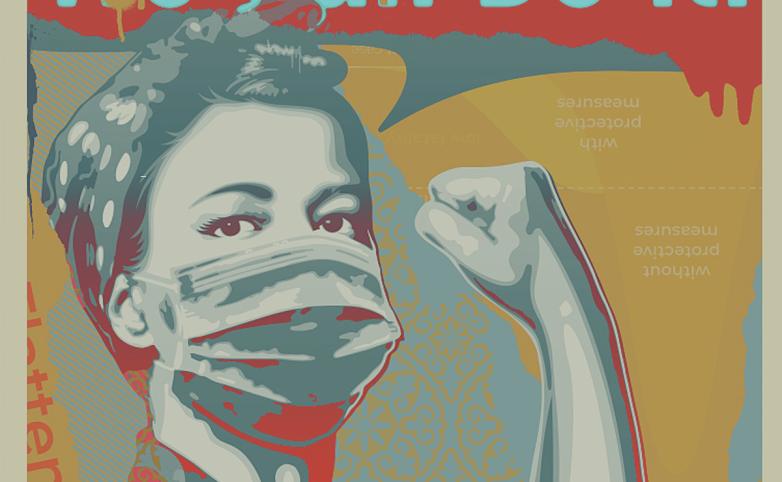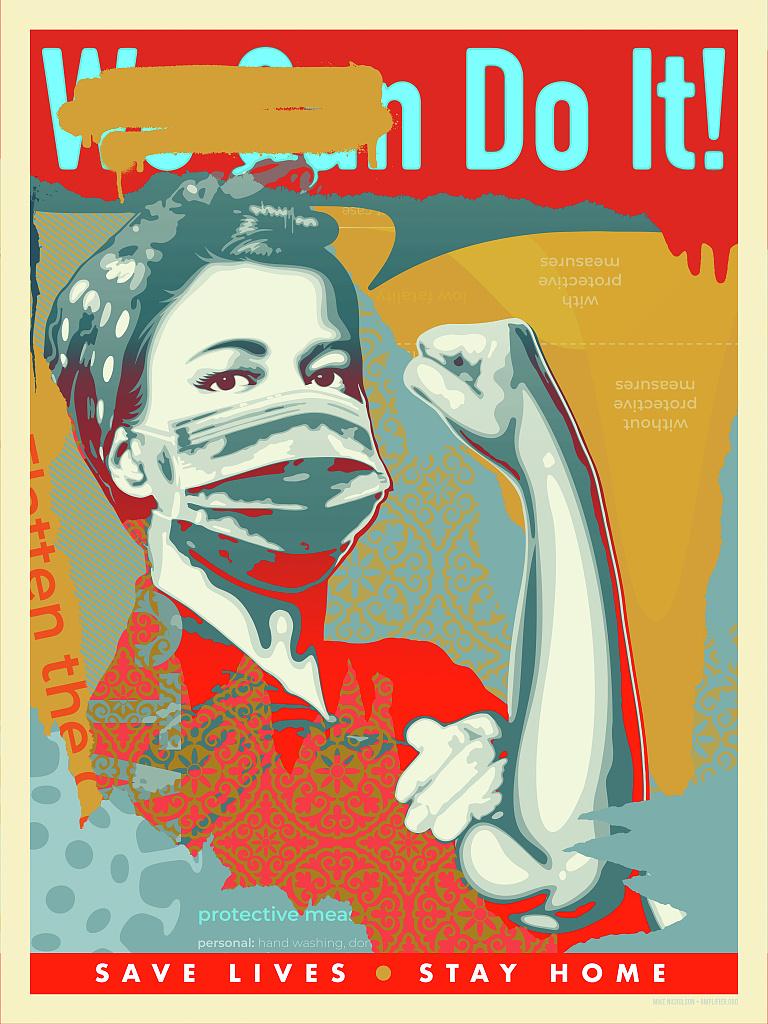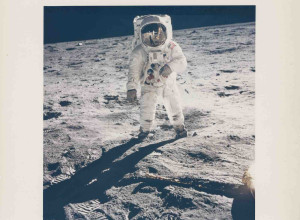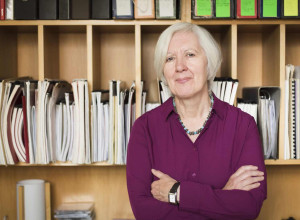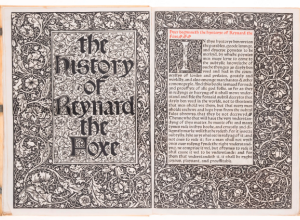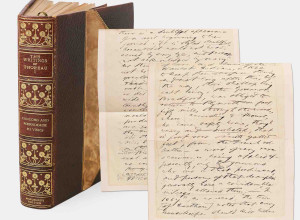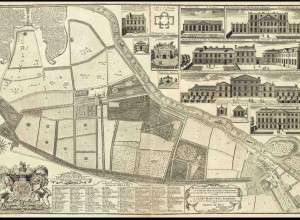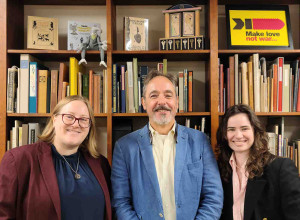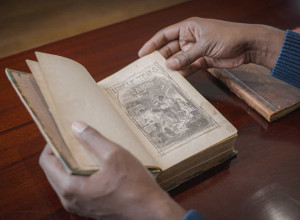“The extraordinary impact of the COVID-19 pandemic in our communities, families and social interactions is unlike anything we’ve seen in the past century,” said Librarian of Congress Carla Hayden. “Archivists and librarians at the Library of Congress are committed to documenting and preserving this difficult time in history through the eyes of artists, photographers, scientists and digital communicators in our collections.”
Here are examples of the Library’s wide-ranging collecting over the past year, along with links to visuals and other materials.
Contemporary Artists Respond to Global Pandemic
In May of 2020, the Library’s Prints & Photographs Division curators and staff specialists carefully selected more than 50 pandemic-related posters for acquisition from the nonprofit Amplifier design lab, and a door opened for receiving digital as well as printed versions of the artworks. Responding to Amplifier’s global open call, such artists as Kimberly Ashby, Gregg Deal, Jena Floyd, Jorge Garza, Akira Ohiso, Alfredo Ponce, Teddy "Stat" Phillips, Lisa Vollrath, Thomas Wimberly, and Jay Yellowhawk created visually-stunning posters with compelling messages aimed at promoting mental health, well-being and social change. A generous Creative Commons license allows downloading of the images from the Library’s online catalog by researchers with appropriate credit to the artist and no commercial use.
American Experiences: Crowdsourcing Photographs and Graphic Art on Flickr
As part of the Library’s rapid-response collecting efforts, the Prints and Photographs Division is collaborating with the photo-sharing site Flickr to invite contributions of digital photographs and graphic art that show how the COVID-19 pandemic has impacted lives, communities, or life in the United States at large. Library curators will review submissions and select images to feature in Flickr galleries and to preserve in the Library’s permanent collections. Learn more about the project and how to participate in this recent blog post.
Community Impact: Photographs by Camilo José Vergara
MacArthur Award-winning photographer Camilo Vergara donated his first group of COVID-19-related images to the Library’s Prints and Photographs Division shortly after the pandemic took off in March 2020. Continuing his longstanding commitment to documenting urban neighborhoods in which poor and under-represented people live, Vergara believes that his photographs will help current and future generations comprehend the impact of the virus. His still-growing pandemic photo series, focusing on New York City neighborhoods, now includes more than 2,000 images in the Library’s collection.
Performing Arts Creative Response to Pandemic
Anyone who investigates the performing arts during this era will encounter many creative responses to the COVID-19 pandemic. This community is creating a wide range of innovative ways to conceive art and share it with audiences, with an equally wide range of motivations: emotional, professional, spiritual, etc. Consequently, the Music Division has undertaken a strategy to capture our nation’s cultural heritage in this unprecedented time by establishing the Performing Arts COVID-19 Response Collection. This carefully curated collection amasses artistic works along with any accompanying primary source materials that document the performing arts creative response to the pandemic. Digital works are beginning to arrive, with some manuscript material expected as the division builds this collection over the next few years.
A Personal Perspective: Toni Lane’s Drawings
Washington, D.C. artist Toni Lane created a series of powerful, highly personal drawings in response to the question “What you do all day while in quarantine?" which was posed in mid-March 2020 by the director of her gallery, Art Enables. They include “Seniors First,” showing an anxious-looking elderly woman amid emptying shelves who Lane encountered while grocery shopping. A colorful, detailed self-portrait shows the artist at work while creating several of the seven total drawings the Prints & Photographs Division acquired for its permanent collection. Lane’s drawings were featured in a Library blog and featured by the news media.
Mapping the Pandemic
The unprecedented nature of the COVID-19 pandemic has produced a large amount of geospatial data and analysis to fight the disease around the world. The Library’s Geography and Maps Division has been monitoring and collecting data that could be useful for future analysis and understanding the history of the pandemic. For example, the Library is taking snapshots of the data released from the Global Initiative for Sharing All Influenza Data, which aggregates rapidly accumulating genomic data from labs around the world during serious disease pandemics, and makes that data available to qualified and registered users. The Library is also collecting analysis from platforms such as Next Strain, which is mapping the mutations of the virus and their transmission. The Library is also collecting the data being released in bulk, from the Johns Hopkins University. Snapshots of this kind of data, maps and other information will be important to understanding this critical moment in the future and to reproduce the analysis being done today.
Archiving the Pandemic Online
The Library has developed and initiated a web collecting plan led by experts in the Science, Technology and Business Division to create a well-balanced collection of archived pandemic-related websites that will be preserved and made available. Subject areas will include government information on the pandemic, social and cultural impacts, scientific material, personal narratives and everyday life. More details on the web archiving plan and examples of sites being archived are available on this blog post. In addition, Library specialists who analyze and recommend web content for archiving have been actively nominating websites over the past year to the International Internet Preservation Consortium’s Novel Coronavirus (COVID-19) Archive-It collaborative project. Library staff nominated content from state government websites in order to archive the evolving responses to the outbreak across the country.
Collecting Across the Library
Divisions across the national library have been acquiring materials that document the extraordinary era of the COVID-19 pandemic through regular collecting work. The U.S. Copyright Office, in particular, has seen a large influx of copyright registrations related to the pandemic over the past year by authors and artists, including works in text, music, motion pictures and visual art. The Law Library of Congress also has acquired dozens of titles related to the pandemic, mostly in languages other than English.

